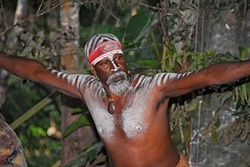Aboriginal Heritage
Uluru–Kata Tjuta is a component of a widespread Aboriginal cultural landscape that stretches across the entire Australian continent. According to ancient legend, ancestral beings named ‘Tjukuritja’ emerged from a void of emptiness and created all living things and the features of the desert landscape we see today. The people of Anangu are said to be the descendants of these ancestral beings and therefore are believed to be responsible for looking after the landscape via the utilisation of traditional Anangu methods that were governed by Tjukurpa (also known as the Anangu Law).

Tjukurpa is what governs all features of life for the Anangu people, from social relationships and personally identity to foraging behaviour and management of the landscape to. This is expressed in numerous cultural methods, ranging from inma (song cycles) and verbal narratives to art and the landscape itself. The Tjukurpa is regarded as the narrative, songs and art for the Anangu.
The Anangu lived according to the traditional methods of life even until the 1930’s, roaming around in family groups and gathering food either by hunting or collecting food from the ground. These people had been the guardians of Uluru-Kata Tjuta by performing ceremonies, conserving water and teaching their knowledge of the land to their younger generations so it wouldn’t be lost.
Even today, there is still a significant amount of Aboriginal heritage available to use from the Anangu. Uluru-Kata Tjuta is the physical heritage which is available to us from the Aboriginal beliefs. In addition, their traditional language still exists, the Pitjantjatara and there is a tourism company which is led by the Anangu.
The Anangu lived according to the traditional methods of life even until the 1930’s, roaming around in family groups and gathering food either by hunting or collecting food from the ground. These people had been the guardians of Uluru-Kata Tjuta by performing ceremonies, conserving water and teaching their knowledge of the land to their younger generations so it wouldn’t be lost.
Even today, there is still a significant amount of Aboriginal heritage available to use from the Anangu. Uluru-Kata Tjuta is the physical heritage which is available to us from the Aboriginal beliefs. In addition, their traditional language still exists, the Pitjantjatara and there is a tourism company which is led by the Anangu.
